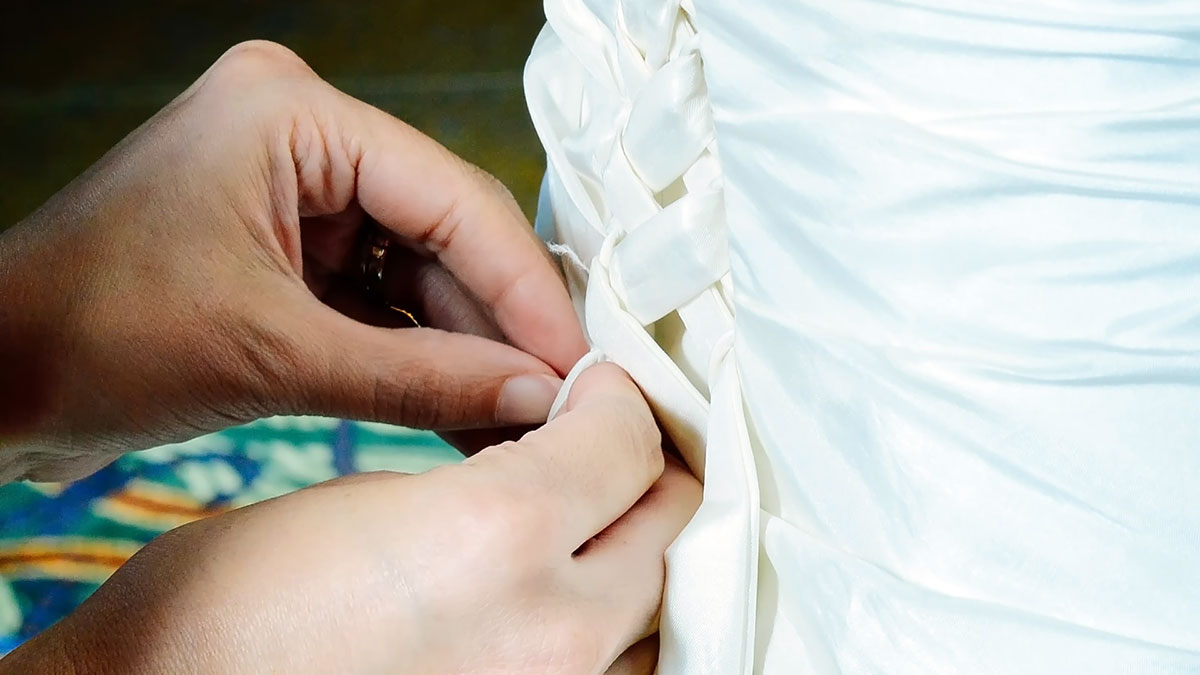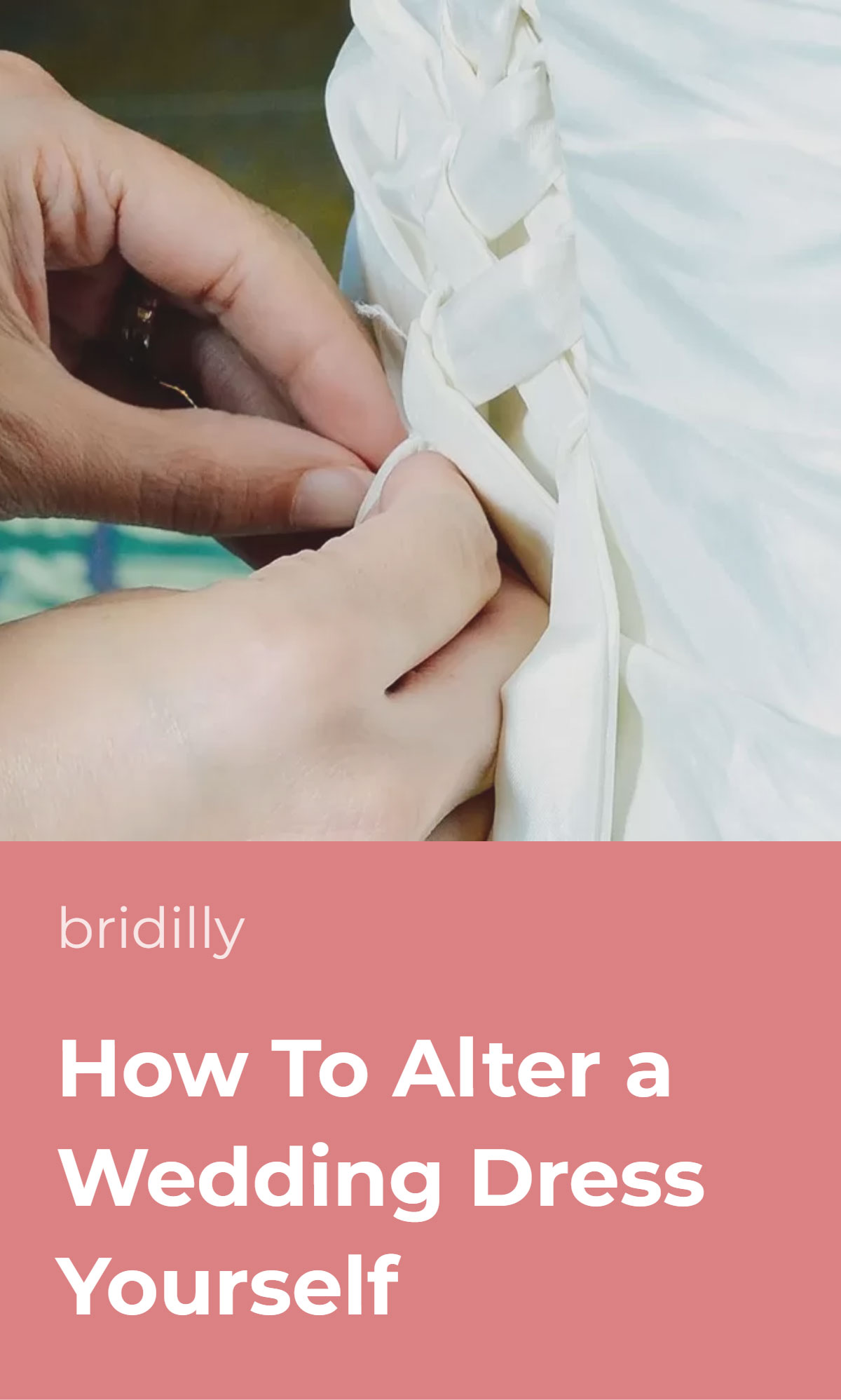If you’re wondering how to alter a wedding dress yourself, you likely haven’t got much time left before the event.
Brides often find out about the necessary alterations at the last moment, and that’s no wonder.
You may have lost a bit too much weight or didn’t try your dress with your heels on until a week prior to the date. Either way, many wedding dress alterations are DIY-friendly if you’re careful enough.
Shortening the hemline, removing the sleeves, or adding a train loop and button typically doesn’t take much time and is manageable even for beginners.
However, if you have zero sewing experience, attempting to take in the waist or replace the sleeves yourself isn’t the brightest idea. Opt for no-sew wedding dress alteration or professional help instead.
Table of Contents [show]
Determine the Alterations
The first step is clearly determining which alterations your wedding dress needs to fit your perfectly. Some alternations may be obvious, while others not so much.
For instance, it’s hard not to notice a loose waistline, but easy to neglect falling straps if you haven’t moved your arms in it or insufficient length if you’ve only tried the dress on with bare feet.
Thus, try on your dress wearing your wedding heels and move around in it like you would on the actual wedding day. The shoe height may affect not only the dress length but also your posture and, consequently, the overall dress fit.
Write down all the necessary changes to create a wedding dress alteration plan. Specific alterations may have to be done before others, so you should know the exact field of work in advance. Remember that you only have one chance.
Many wedding dresses have a long train that looks stunning in pictures but is highly uncomfortable to walk around with.
Adding a train loop and button will allow you to lift the train and attach it to the back of your gown after the ceremony.
That’s one of the easiest DIY wedding dress alterations, but you will need the help of a friend. Put the dress on while standing on your wedding heels and ask your friend to lift the train.
Then, ask them to attach the train end to the middle back of your waist using a safety pin. Depending on the length of your train, you may need to attach it to a lower point, for instance, under your bum.
Sew a button in the place of a safety pin – of course, the button should match the dress design. You can find some fancy options online or in a local sewing store.
Use a ribbon or rubber band of matching color to sew a loop to the bottom of your train. Strive to sew it to the hem or another place where it won’t be overly visible.
Finally, take the dress on again and check whether the train drapes as you want. Alternatively, you may make a trendy pearl wrist loop instead of a waist-attached loop.
Taking In the Waist
DIY wedding dress waist alteration isn’t an easy task. You should have intermediate sewing skills and some experience in altering garment waistline, as reversing this type of alteration can be complex.
First, determine how much fabric must be taken off. Take the dress on and pinch excess fabric where the stitches are. If the stitches are on the sides, use safety pins to mark material that must be removed from the sides.
Some dresses only have stitches on the back. In this case, you should take off an even amount of fabric from both sides of the stitch.
Then, remove any embellishments close to the stitches you’re going to alter.
Turn the dress inside out and replace the safety pins to the reverse side. Insert them along the seamline and use chalk to draw the new seamline along the pins.
Use a sewing machine to sew a new straight stitch along the chalk seamline and repeat the process from another side if you’re taking off the dress waist from the sides.
Take the dress on again. If you’re satisfied with the result, you may cut off the excess fabric on the inner side of your dress. However, leaving it will allow you to alter the waist for a bigger size in the future.
Hem Alterations
Shortening the hemline is one of the most common wedding dress alterations. Bridal wear manufacturers tend to make the hem extra long to ensure that the dress fits any bride, even on extremely high heels.
The thing is, shortening the hem is much easier than making it longer. This can be done even without extensive prior experience, though you should know the basics of using a sewing machine.
First, take on your dress (don’t forget about your heels) and measure the desired length using a measuring tape.
You may ask a friend to help, as measuring the length correctly while you bend may be tricky. You should stay in your natural stance with a straight posture when doing it.
After the length is determined, take the dress off and lay it on a flat surface. Then, use a chalk or fabric pencil to mark dots along the hemline according to your measurements. Connect the dots around the skirt circumference.
The best way to shorten a dress is by using a sewing machine, as a hand-sewn hem may not look very neat. Create a double fold along the chalk-drawn hemline and stitch it into place. Then, cut off the excess fabric.
Note that this method won’t work with sheer fabrics, as the stitch will be visible.
If your wedding dress has a layered chiffon or tulle skirt, consider using fabric glue or shortening the dress from the waist (this requires a higher skill level, though).
If you need to make your wedding dress hem longer, consider opting for professional alteration services.
You would need to find a suitable fabric and sew it to the bottom of the dress, which doesn’t always look great if done by a non-professional.
Sleeve Alteration
Wedding dress sleeve alterations vary drastically by difficulty level. Making sleeves shorter is relatively easy, while entirely changing the sleeve style requires some skill.
The process of shortening wedding dress sleeves is not much different from shortening the hem. First, take the dress on and carefully insert safety pins along the new desired sleeve seamline.
Make sure to hang your hands down while doing it, and bear in mind that the sleeves will go up slightly when you fold the arm.
Fold the fabric along the newly drawn seamline and create a straight stitch using a sewing machine. Then, cut off the excess fabric from the sleeve’s inner side.
One of the most popular wedding dress alterations is sleeve removal. That’s a common case with long sleeve dresses. Do you wish to make your dress sleeveless? Well, this can be done in no time.
Turn your dress inside out and use a seam ripper to remove the armhole stitching. Be careful not to damage the delicate dress fabric. Most likely, the raw edges of your dress armhole are finished with an overlock stitch.
In this case, you should also remove the overlock stitching to separate the sleeve from the dress. Once this is done, fold the fabric at about ¼ inches from the raw edge and draw a new seamline with chalk.
Use bobby pins to secure the folded fabric edge in place while you’re working with it. Lastly, make a new stitch using a sewing machine or fix the fabric edge with double-sided hem tape.
No-Sew Solutions
If you don’t have any sewing skills, not to worry – there are plenty of no-sew wedding dress alteration solutions.
Brides who don’t own a sewing machine can shorten the dress hem or sleeves using hem tape. It’s a double-sided fabric adhesive strip that allows you to temporarily alter your dress hem without cutting it or making new stitches.
Some minor alterations can also be made using bobby pins. For instance, you may pin the train to your waist after the ceremony instead of adding a button and a loop.
In this case, make sure the pin is strong enough to hold heavy dress fabric and isn’t visible. Alternatively, you may find a fashion pin or a brooch to make it a statement attire element.
If your dress waist is too loose, but the bust and hips are of the correct size, consider finding a suitable belt instead of taking in the sides. It may make your look even more beautiful without all the hassle.
Consult a Seamstress for Free
Each dress is unique and requires an individual approach. This guide provides general dress alteration instructions, but if you aren’t sure whether they are suitable for your dress, consider consulting a local seamstress.
Consultations are usually free, so there’s no harm in asking and no commitment involved. Many seamstresses will be happy to give you tips on altering your wedding dress at home.
And if the alteration is too difficult for an inexperienced person, request the seamstress a quote. After all, the price may not be as high as you think, and trusting your dress to a professional is always a good idea.













No Comments Add one
Leave a Comment